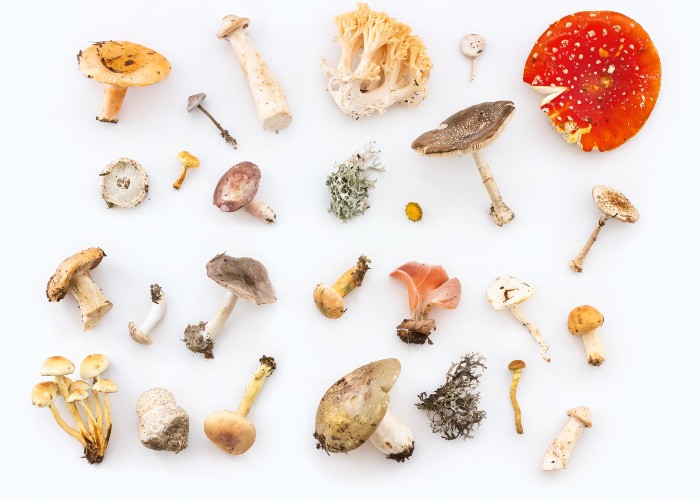Medicinal mushrooms have been in use for hundreds of years, especially in East Asia. These mushrooms have been marveled for their nutritional value as well as health benefits, including antimicrobial, anti-inflammatory, and anti-cancer abilities [1]. These medicinal mushrooms are studied for their immune modulation abilities where they affect and stimulate natural killer cells, macrophages, T cells and dendritic cells to name a few. With more research backing the numerous health benefits of mushrooms, these superfoods are being sold in various formats and supplement forms for current commercial use.
Cordyceps
Chinese medicine, Cordyceps sinensis, has gained popularity for its immune enhancing properties. Cordycepin and cordycepic acid, being the primary bioactive components, have immunomodulatory activity. Previous studies show therapeutic effects on respiratory, renal, hepatic diseases as well as antitumor activity [2-4]. In one clinical trial, patients with moderate to severe asthma showed improvement in asthma symptoms, lung function and inflammatory profile [5].
Reishi
Another popular medicinal mushroom, Ganoderma lucidum, otherwise known as Reishi is used as an anticancer herb and as an immunostimulatory supplement sold and consumed in forms such as powders, capsules, tea and even kombucha where it was shown to have antibacterial effects [6]. Reishi’s bioactive components range over many different compounds, the most important being its’ triterpenoids and polysaccharides [7]. In fact, the mushroom’s triterpenoids have proved cytotoxic activity on cancerous cells in vitro as well as anti-HIV activity where it showed inhibitory activity against some HIV proteases [7, 8]. Although clinical trials are very few and far for this fungus, there are proven in vitro studies that show Reishi’s immune effects as well as anticancer potential.
Chaga
Inonotus obliquus, otherwise more commonly known as Chaga mushroom has been used in several countries for medicinal value due to its antibacterial, anti-inflammatory, antioxidant, and antitumor activities [9]. These activities are primarily due to the bioactive compounds present in the mushroom, betulinic acid and inotodiol [10]. Chaga mushrooms also have antioxidant abilities where it can scavenge free radicals, protect cells against oxidative stress, inhibit hydrogen peroxide induced apoptosis and premature senescence [11, 12]. These therapeutic benefits contribute to enhanced immune functioning.
While it is evident that medicinal mushrooms have tremendous therapeutic potentials, bioactive molecules in mushrooms that are beneficial are not readily bioavailable. Cell walls of mushroom cells surrounding such bioactive molecules are composed of chitin which also occurs in the exoskeleton of insects and crabs. There are individual differences in capability to digest chitin, but majority cannot breakdown chitin properly, resulting in non-extracted mushrooms’ poor bioavailability and ultimately unpredictable outcomes [13]. Fortunately, there are extraction processes (for instance, hot-water extraction method) that releases bioactive molecules. Since manufacturers usually do not disclose the products’ bioavailability on their labels, average consumers are not aware of the importance of extraction process. Regardless of how therapeutic natural products are, if human bodies cannot absorb them properly, we cannot benefit from them. Enhancing bioavailability and absorption for ideal onset of action and effectiveness is a crucial last step of any therapeutic natural product supplements.
- El Enshasy HA, Hatti-Kaul R. Mushroom immunomodulators: unique molecules with unlimited applications. Trends in Biotechnology. 2013;31(12):668-677.
- Das SK, Masuda M, Sakurai A, Sakakibara M. Medicinal uses of the mushroom Cordyceps militaris: Current state and prospects. Fitoterapia. 2010;81(8):961-968.
- Yue GG-L, Lau CB-S, Fung K-P, Leung P-C, Ko W-H. Effects of Cordyceps sinensis, Cordyceps militaris and their isolated compounds on ion transport in Calu-3 human airway epithelial cells. Journal of Ethnopharmacology. 2008;117(1):92-101.
- Hsu C-H, Sun H-L, Sheu J-N, et al. Effects of the Immunomodulatory Agent Cordyceps militaris on Airway Inflammation in a Mouse Asthma Model. Pediatrics & Neonatology. 2008;49(5):171-178.
- Wang N, Li J, Huang X, Chen W, Chen Y. Herbal Medicine<i> Cordyceps sinensis</i> Improves Health-Related Quality of Life in Moderate-to-Severe Asthma. Evidence-Based Complementary and Alternative Medicine. 2016;2016:6134593.
- Sknepnek A, Pantić M, Matijašević D, et al. Novel Kombucha Beverage from Lingzhi or Reishi Medicinal Mushroom, <i>Ganoderma lucidum</i>, with Antibacterial and Antioxidant Effects. 2018;20(3):243-258.
- Boh B, Berovic M, Zhang J, Zhi-Bin L. Ganoderma lucidum and its pharmaceutically active compounds. In: El-Gewely MR, ed. Biotechnology Annual Review. Vol 13. Elsevier; 2007:265-301.
- El-Mekkawy S, Meselhy MR, Nakamura N, et al. Anti-HIV-1 and anti-HIV-1-protease substances from Ganoderma Lucidum. Phytochemistry. 1998;49(6):1651-1657.
- Shashkina MY, Shashkin P, Sergeev A. Chemical and medicobiological properties of chaga. Pharmaceutical Chemistry Journal. 2006;40(10):560-568.
- Géry A, Dubreule C, André V, et al. Chaga (Inonotus obliquus), a Future Potential Medicinal Fungus in Oncology? A Chemical Study and a Comparison of the Cytotoxicity Against Human Lung Adenocarcinoma Cells (A549) and Human Bronchial Epithelial Cells (BEAS-2B). Integrative Cancer Therapies. 2018;17(3):832-843.
- Yun JS, Pahk JW, Lee JS, Shin WC, Lee SY, Hong EK. Inonotus obliquus protects against oxidative stress-induced apoptosis and premature senescence. Molecules and Cells. 2011;31(5):423-429.
- Cui Y, Kim D-S, Park K-C. Antioxidant effect of Inonotus obliquus. Journal of Ethnopharmacology. 2005;96(1):79-85.
- Coy, C., Standish, L. J., Bender, G., & Lu, H. (2015). Significant Correlation between TLR2 Agonist Activity and TNF-α Induction in J774.A1 Macrophage Cells by Different Medicinal Mushroom Products. International journal of medicinal mushrooms, 17(8), 713–722. https://doi.org/10.1615/intjmedmushrooms.v17.i8.20

